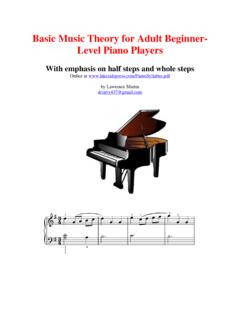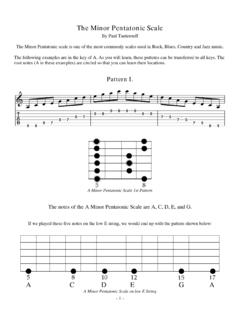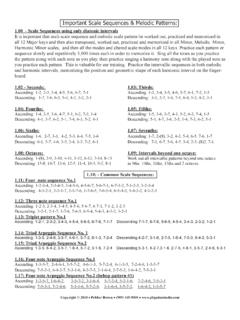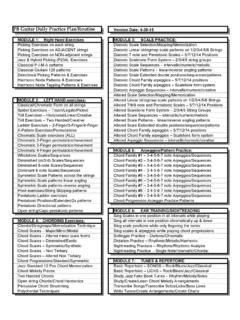Transcription of Basic Music Theory for the Native American Flute (NAF)
1 1 Basic Music Theory for the Native American Flute (NAF) By Lawrence Martin Author of: Notes for the beginning ukulele player An introduction to Basic Music Theory for the ukulele INTRODUCTION (Table of Contents on Page 3) The title may sound like advertising gas prices to owners of an electric car. People take up the NAF because it s a relatively simple instrument, one that can be played without worrying about scales and intervals and the dreaded Music Theory . Some of the best NAF players don t even read Music ! (This is also true of many musicians who play the fiddle and other folk instruments.) You don t need Basic Music Theory to play the NAF.
2 Nonetheless, it helps to understand Basic Music Theory for any instrument you play, even the simplest ones. For the NAF, such knowledge can answer a whole lot of questions, such as: why tablature works for any NAF you may own; why the pentatonic minor scale is played the same on a 5- and 6-hole Flute ; why your Flute in the key of A (or G, or most others) does not play the actual notes shown on NAF tablature; why you may need a different Flute if you play in a group; etc. If you ve read this far, I assume you have some interest in NAF Music Theory . You may have even read about it, in books or online. If so, chances are these sources did not adequately explain the subject, or they may have left you a little confused.
3 That was certainly my own situation when I took up the NAF and tried to learn Basic Theory from books and web sites a certain degree of frustration and confusion. For example, I found that the notes in NAF tablature did not correlate with the notes I was playing on my A Flute . The explanation was there somewhere, just not clearly explained. Why not? One reason is that Music Theory explanations are written by musicians. Musicians obviously understand the subject but often don t have a good grasp of what we beginners, non-musicians, musical dolts don t know. Put another way, they may assume we know more than we actually do.
4 2 Perhaps the best way to learn Basic Music Theory is to study piano, so I began Piano 101. I also took up the ukulele, and by studying both instruments gradually learned about musical keys, scales and intervals. To help me better understand the uke, I wrote a beginner s Music Theory book for the instrument, which has been well received on uke forums. Then I decided to create a similar syllabus for the NAF from the perspective of a beginner and a definite non-musician. Writing this syllabus has helped me better understand the NAF, and I believe it should help most non-musicians as well. If you follow this syllabus step by step, and do the simple exercises I recommend, you should achieve a much deeper understanding of the NAF than you now possess.
5 The syllabus is not a quick read, especially if you have no musical background. I have simplified the material as much as feasible, while still presenting what I believe are the essentials for understanding Basic NAF Music Theory . It is divided into four parts, with 3 steps in each part. I recommend doing only one part at a time, and even that may be broken up into a couple of sessions. However you choose to proceed, I advise not going to a new step until you feel thoroughly comfortable with the previous one. NOTE. This syllabus does not teach how to blow into the Flute , or how to hold it or cover the holes, or anything about the how the Flute is designed.
6 The syllabus assumes you: 1) have a NAF; 2) know how to hold and blow into it to sound a note; 2) have access to the internet (smart phone, tablet or computer). If you need instruction on how to hold, blow and cover the Flute holes, I highly recommend a Youtube video by master player and Flute maker Odell Borg. The URL below is Part 1 of a 6-part series by Borg on Flute basics. The other five parts follow without having to enter a new URL. If you are brand new to the NAF, you might enjoy a comprehensive video Getting Started: The Beginner s Guide to the Native American Style Flute at If you have specific questions about the NAF, chances are you ll find the answer in Flutopedia, an online encyclopedia of everything about the Native American Flute ( ).
7 I refer frequently to this essential work in the syllabus. The green-shaded finger tab diagram used throughout is courtesy of Clint Goss, 3 Basic Music Theory FOR THE NAF Photo from High Spirits Flutes, PAGE PART 1 Flute KEYS AND THE pentatonic scale .. 4 PART 2 SCALES, THE KEYBOARD AND THE TREBLE CLEF .. 10 PART 3 THE pentatonic scale : KEYBOARD AND TREBLE CLEF .. 19 PART 4 NAF 28 NAF Music Theory MULTIPLE CHOICE QUIZ .. 37 NAF Music Theory MULTIPLE CHOICE QUIZ ANSWERS .. 40 REFERENCES AND RESOURCES .. 41 4 PART 1 Flute KEYS AND THE pentatonic scale STEP 1. Play the pentatonic minor scale on your NAF.
8 This is the primary scale all modern NAFs are designed to play. Penta means five, but you ll play 6 notes; the 1st (lowest) and 6th (highest) are the same note, the latter an octave higher than the former. Later I ll define pentatonic but for now just play this standard Basic scale one note at a time, as shown below, starting from left to right. Dark circles are closed holes. The mouth end is at the top. Thus the lowest note has all holes closed, and the highest note has just one hole closed, the 4th from the bottom. Lowest note ---------------------------------------H ighest Note Figure from: Watch the following videos if you re not familiar with playing this scale .
9 NOTE: If you have a 5-hole Flute , keep your fingers in the same position as on a 6-hole Flute . As you ll see, the 4th hole from the bottom is always covered when playing this scale , so it doesn t matter if you have a 5- or 6-hole Flute . * Keep the 4th hole covered at all times when playing the minor pentatonic scale . *4th Hole -> 5 STEP 2. Check the key of your Flute . The musical key indicates the pitch of sounds when the notes are played. A key of A minor will have notes of a certain pitch: higher, for example, than a key of F# minor . Each NAF has its own unique musical key; if you want to play in another key, you need another NAF.
10 (This is in contrast to a piano or guitar, for example, which can play in many keys). Except for pocket flutes, the key is usually printed somewhere on the body, as a single letter, , A or F#. For pocket flutes it may be printed on a tag, , G. (See figures below of three High Spirits flutes). Although not written out on the Flute or the tag, these letters stand for the key of A minor , F# minor and G minor . Back of Flute showing key of A ( minor ) 6 Back of Flute showing key of F# ( minor ) Tag that comes with pocket Flute indicating it is in key of G 7 STEP 3. Play the scale again with a tuner and write down the notes you play.









